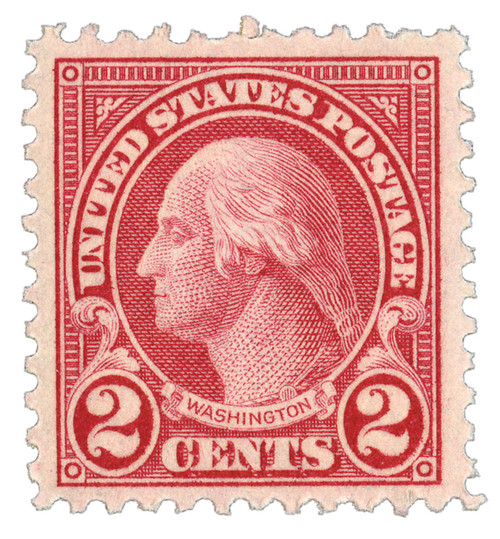
# 519 - 1917 2c Washington, carmine, double line watermark, perf 11
1917 2¢ Washington
Design of 1908-09
Issue Date: October 10, 1917
Printed by: Bureau of Engraving and Printing
Method: Flat plate
Watermark: Double line
Perforation: 11
Color: Carmine
On or around April 29, 1895, the US Post Office began issuing postage stamps with watermarks. The practice was introduced by the Bureau of Engraving and Printing (BEP) and only lasted a little over 20 years. From 1870 to 1894, US postage stamps were printed by a series of Bank Note companies. As each company won the contract, the printing plates were handed off to the next company and small changes were made to differentiate between them. In 1894, the BEP won the contract, and would produce most US stamps for the next 75 years. When they took over stamp printing, the BEP received all the existing stamp dies, rolls, plates, and paper from the American Bank Note Company. To distinguish their stamps from the ones before them, they added triangles to the upper corners of the stamps. These stamps are known as the First Bureau Issues and are US #246-63. While these were the first postage stamps the Bureau printed, they had been printing US revenue stamps since 1862. Around 1878, they started printing revenues on watermarked paper. This was to satisfy a law that required government securities to be printed on watermarked paper. The BEP likely believed that US stamps fell into this category of securities and began preparing watermarked paper for US postage stamps. However, they used up their existing stock of unwatermarked paper until it was gone. A watermark is a pattern impressed into the paper during its manufacture. While still in the wet pulp stage, the paper passes through a “dandy roller” which has “bits” attached to it. These bits are pressed into the paper, causing a slight thinning, thus imprinting the design. US #264 was the first stamp issued on this paper, on or around April 29, 1895. The first US watermark consisted of the letters USPS (United States Postal Service) and is described as “double-lined.” The letters were repeated across the entire sheet, and as a result, only a portion of one or more letters appear on a stamp. Occasionally, a stamp will have a complete letter on it. When the stamps were printed, no thought was given to the position of the watermark. Consequently, some watermarks were backwards, upside-down, backwards and upside-down, or sideways in relation to the stamp. None are unusual or considered a separate variety. You can view a double-line watermarked stamp here. Errors were made, however, on the 6¢ Garfield and the 8¢ Sherman, when some of the stamps were printed on sheets watermarked USIR (United States Internal Revenue). Since the BEP printed regular issue postage stamps, as well as revenue stamps, it’s easy to see how such a mistake may have happened. Some believe the switch may have been deliberate, because not enough properly marked paper was available. The Bureau continued to use watermarked paper for several years. In 1910, they made the decision to change the USPS watermark. In addition to reducing the size of the letters, the style was changed from a double line to a single line. The purpose was to strengthen the paper and give it a more uniform thickness, since the old watermark tended to weaken the structure of the paper. The 1913 Panama-Pacific Expo stamps (#397-404) were the only commemoratives printed on the single-line watermark paper, while the rest were Washington-Franklins. Since money was in short supply due to the economic pressures of World War I, the watermark was discontinued in 1916 to cut back on production costs at the Bureau. By not using the specially produced watermarked paper, a large amount of money could be saved. It was decided that this savings was so significant, it outweighed the risk of counterfeiting. No more stamps were intentionally printed on watermarked paper after that, though there were two notable errors – US #519 and #832b.U.S. Stamps Printed on Watermarked Paper
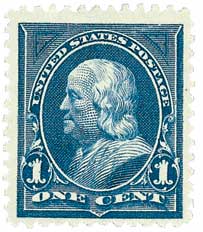
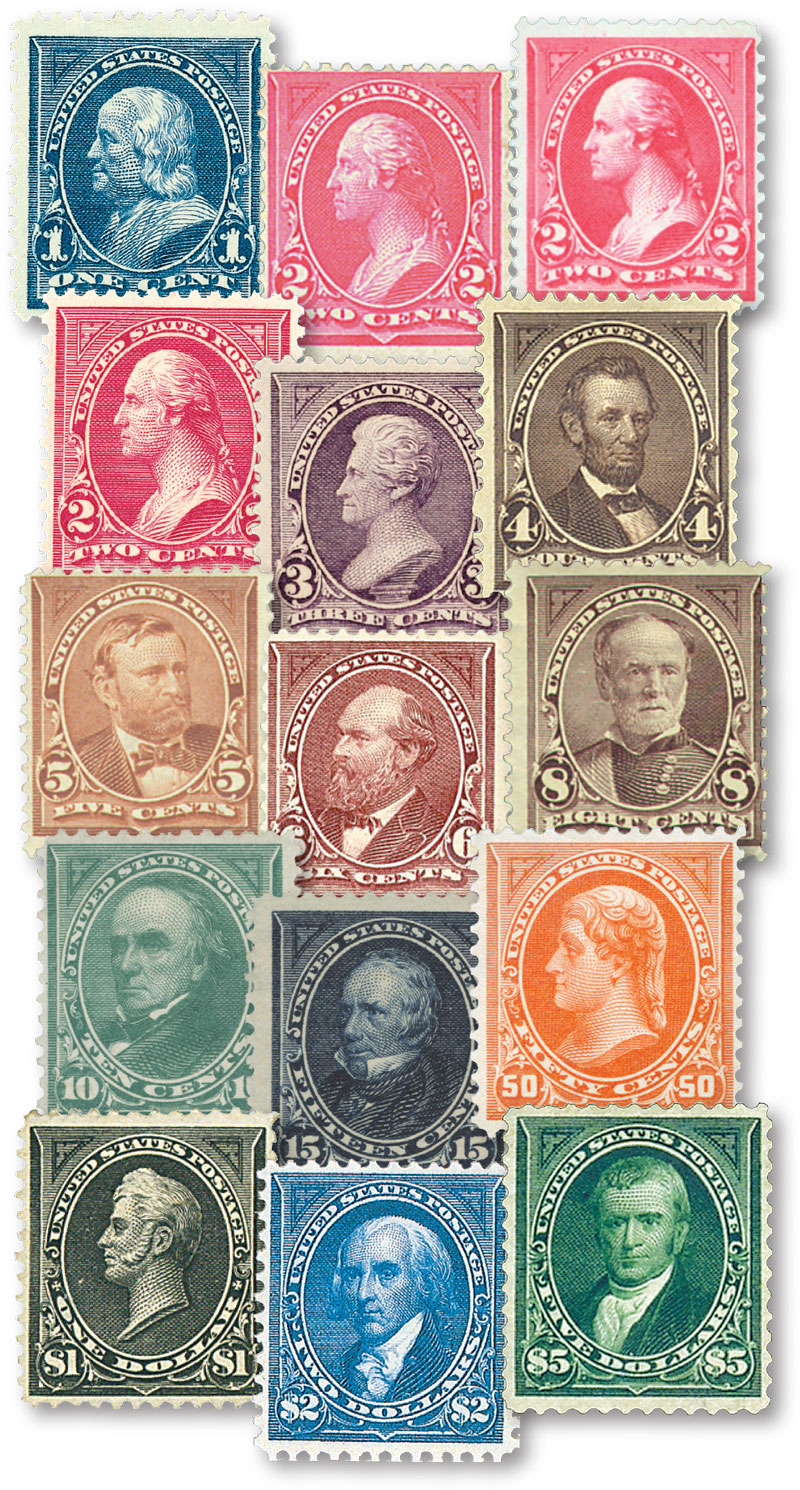
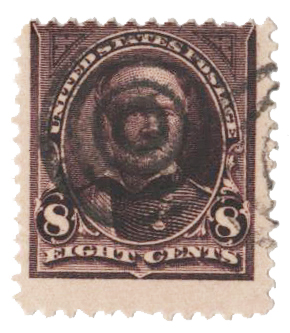
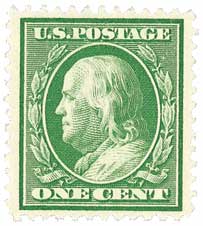
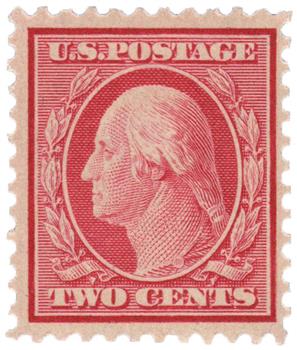
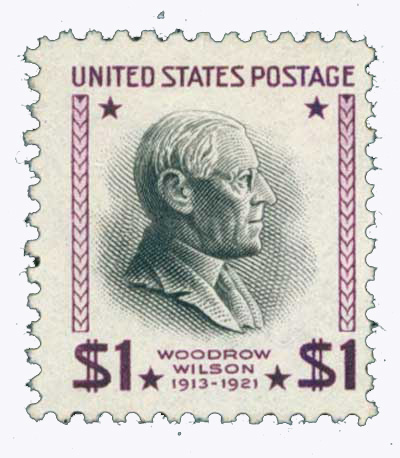
If you need supplies to identify your stamps, we have a watermark tray and watermark fluid.
1917 2¢ Washington
Design of 1908-09
Issue Date: October 10, 1917
Printed by: Bureau of Engraving and Printing
Method: Flat plate
Watermark: Double line
Perforation: 11
Color: Carmine
On or around April 29, 1895, the US Post Office began issuing postage stamps with watermarks. The practice was introduced by the Bureau of Engraving and Printing (BEP) and only lasted a little over 20 years. From 1870 to 1894, US postage stamps were printed by a series of Bank Note companies. As each company won the contract, the printing plates were handed off to the next company and small changes were made to differentiate between them. In 1894, the BEP won the contract, and would produce most US stamps for the next 75 years. When they took over stamp printing, the BEP received all the existing stamp dies, rolls, plates, and paper from the American Bank Note Company. To distinguish their stamps from the ones before them, they added triangles to the upper corners of the stamps. These stamps are known as the First Bureau Issues and are US #246-63. While these were the first postage stamps the Bureau printed, they had been printing US revenue stamps since 1862. Around 1878, they started printing revenues on watermarked paper. This was to satisfy a law that required government securities to be printed on watermarked paper. The BEP likely believed that US stamps fell into this category of securities and began preparing watermarked paper for US postage stamps. However, they used up their existing stock of unwatermarked paper until it was gone. A watermark is a pattern impressed into the paper during its manufacture. While still in the wet pulp stage, the paper passes through a “dandy roller” which has “bits” attached to it. These bits are pressed into the paper, causing a slight thinning, thus imprinting the design. US #264 was the first stamp issued on this paper, on or around April 29, 1895. The first US watermark consisted of the letters USPS (United States Postal Service) and is described as “double-lined.” The letters were repeated across the entire sheet, and as a result, only a portion of one or more letters appear on a stamp. Occasionally, a stamp will have a complete letter on it. When the stamps were printed, no thought was given to the position of the watermark. Consequently, some watermarks were backwards, upside-down, backwards and upside-down, or sideways in relation to the stamp. None are unusual or considered a separate variety. You can view a double-line watermarked stamp here. Errors were made, however, on the 6¢ Garfield and the 8¢ Sherman, when some of the stamps were printed on sheets watermarked USIR (United States Internal Revenue). Since the BEP printed regular issue postage stamps, as well as revenue stamps, it’s easy to see how such a mistake may have happened. Some believe the switch may have been deliberate, because not enough properly marked paper was available. The Bureau continued to use watermarked paper for several years. In 1910, they made the decision to change the USPS watermark. In addition to reducing the size of the letters, the style was changed from a double line to a single line. The purpose was to strengthen the paper and give it a more uniform thickness, since the old watermark tended to weaken the structure of the paper. The 1913 Panama-Pacific Expo stamps (#397-404) were the only commemoratives printed on the single-line watermark paper, while the rest were Washington-Franklins. Since money was in short supply due to the economic pressures of World War I, the watermark was discontinued in 1916 to cut back on production costs at the Bureau. By not using the specially produced watermarked paper, a large amount of money could be saved. It was decided that this savings was so significant, it outweighed the risk of counterfeiting. No more stamps were intentionally printed on watermarked paper after that, though there were two notable errors – US #519 and #832b.U.S. Stamps Printed on Watermarked Paper






If you need supplies to identify your stamps, we have a watermark tray and watermark fluid.


















